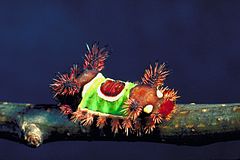Saddleback caterpillar
| Saddleback Caterpillar | |
|---|---|

| |
| Scientific classification | |
| Kingdom: | |
| Phylum: | |
| Class: | |
| Order: | |
| Family: | |
| Genus: | |
| Species: | S. stimulea
|
| Binomial name | |
| Sibine stimulea (Clemens, 1860)
| |
| Synonyms | |
| |
The saddleback caterpillar, Sibine stimulea, is the larva of a species of moth native to eastern North America. The species belongs to the family of slug caterpillars, Limacodidae. It is also known as the "packsaddle".
The caterpillars are primarily green with brown at either end, and a prominent, white-ringed brown dot in the center which resembles a saddle, hence the name. They feed on a large variety of plants, and the adults are dark brown, stout-bodied moths. In Florida, they are known to feed on ornamental palms such as the Adonidia merrilli (Christmas palm).
These caterpillars have a pair of fleshy "horns" at either end, and these, like much of the body, bear urticating hairs that secrete an irritating venom. Stings can be very painful. They can cause swelling, nausea, and leave a rash that can last for days. Individuals with sensitive skin are cautioned against coming into contact with them as the reaction can be more severe than the typical reaction.[1]
Gallery
-
Acharia stimulea larva; Washington, D.C.

